助您决策的交易策略
探索实用策略与方法,提升您的规划、分析与执行力。


Most traders understand EA portfolio balance through the lens of traditional risk management — controlling position sizes, diversifying currency pairs, or limiting exposure per trade.
But in automated trading, balance is about deliberately constructing a portfolio where different strategies complement each other, measuring their collective performance, and actively managing the mix based on those measurements.
The goal is to create a “book” of EAs that can help diversify performance over time, even when individual strategies hit rough patches.
A diversified mix of EAs across timeframes and assets can, in some cases, reduce reliance on any single strategy. This approach reduces dependency on any single EA’s performance, smooths your overall equity curve, and builds resilience across changing market conditions.
It’s about running the right mix, identifying gaps in your coverage, and viewing your automated trading operation as an integrated whole rather than a collection of independent systems.
Basic Evaluation Metrics – Your Start Point
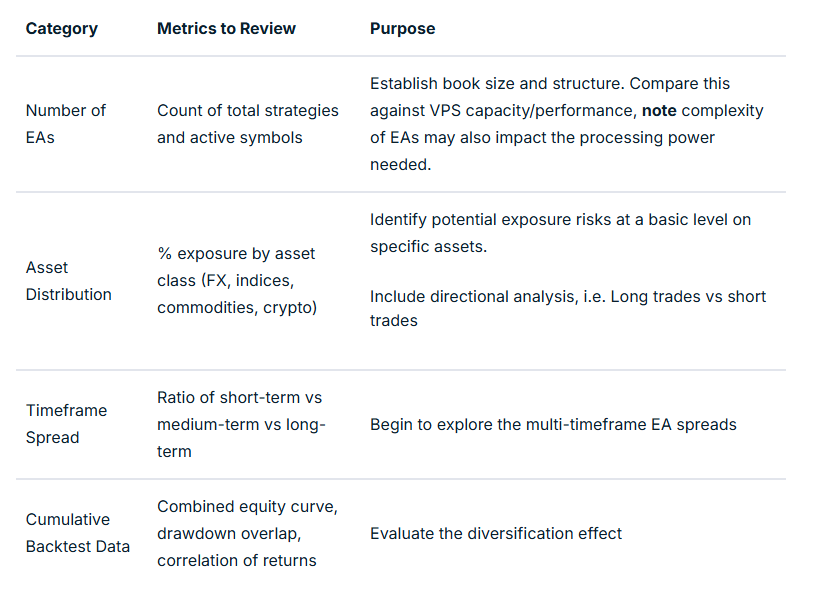
Temporal (timeframe) Balancing
When combined, a timeframe balance (even on the same model and instrument) can help flatten equity swings.
For example, a losing phase in a fast-acting M15 EA can often coincide with a profitable run in an H4 trend model.
Combining this with some market regime and sessional analysis can be beneficial.
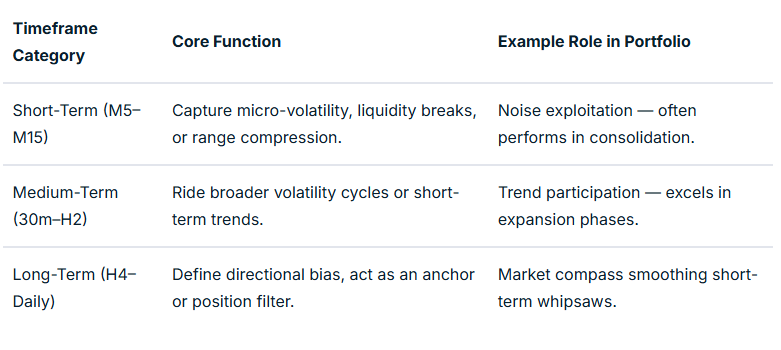
Asset Balance: Managing Systemic Correlation Risk
Running five different EAs on USDJPY might feel diversified if each uses different entry logic, even though they share the same systemic market driver.
But in an EA context, correlation measurement is not necessarily between prices, but between EA returns (equity changes) relating to specific strategies in specific market conditions.
Two EAs on the same symbol might use completely different logic and thus have near-zero correlation.
Conversely, two EAs on a different symbol may feel as though they should offer some balance, but if highly correlated in specific market conditions may not achieve your balancing aim.
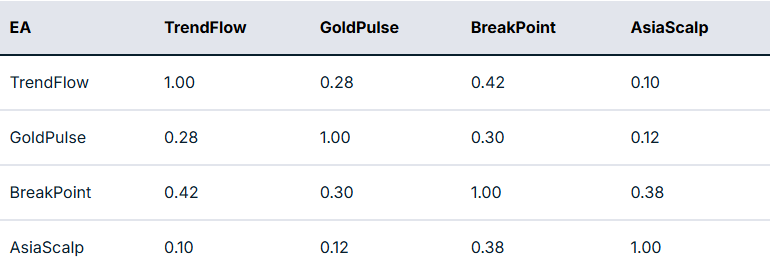
In practical terms, the next step is to take this measurement and map it to potential actionable interventions.
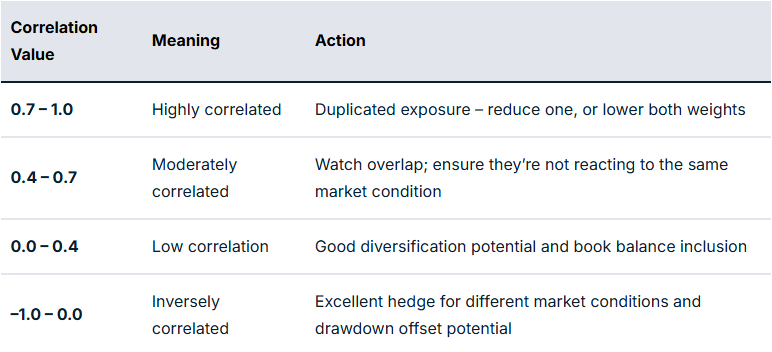
For example, if you have a EURUSD Trend EA and a GBPUSD Breakout EA with a correlation of 0.85, they are behaving like twins in performance related to specific market circumstances. And so you may want to limit exposure to some degree if you are finding that there are many relationships like this.
However, if your gold mean reversion EA correlates 0.25 compared to the rest of your book, this may offer some balance through reducing portfolio drawdown overlap.
Directional and Sentiment Balance
Markets are commonly described as risk-on or risk-off. This bias at any particular time is very likely to impact EA performance, dependent on how well balanced you are to deal with each scenario.
You may have heard the old market cliché of “up the staircase and down the elevator shaft” to describe how prices may move in alternative directions. It does appear that optimisation for each direction, rather than EAs that trade long and short, may offer better outcomes as two separate EAs rather than one catch-all.
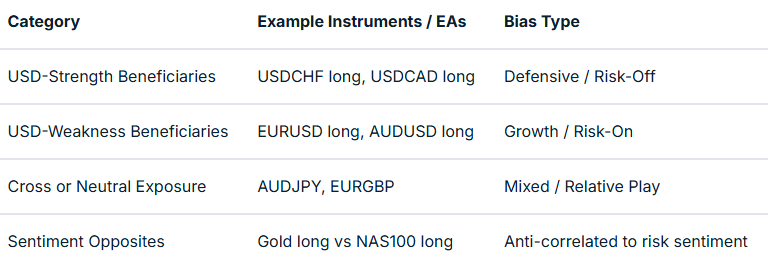
Market Regime and Volatility Balance
Trend and volatility states can have a profound impact on price action, whether as part of a discretionary or EA trading system. Much of this has a direct relationship to time of day, including the nature of individual sessions.
We have a market regime filter that incorporates trend and volatility factors in many EAs to account for this. This can be mapped and tested on a backtest and in a live environment to give evidence of strategy suitability for specific market conditions.
For example, mean reversion strategies may work well in the Asian session but less so in strongly trending markets and the higher volatility of the early part of the US session.
As part of balancing, you are asking questions as to whether you actually have EA strategies suited to different market regimes in place, or are you using these together to optimise book performance?
The table below summarises such an approach of regime vs market mapping:
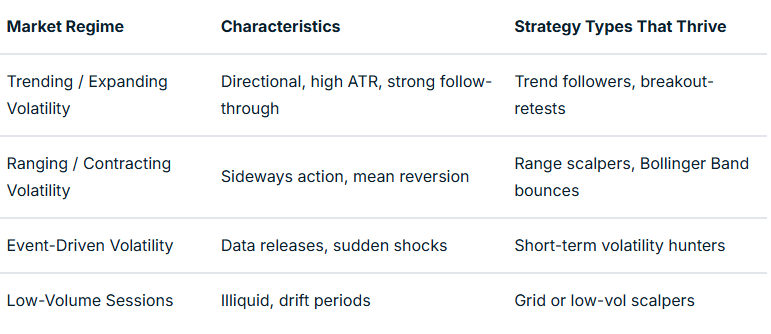
Multi-Level Analysis: From Composition to Interaction
Once your book is structured, the challenge is to turn it into something workable. An additional layer of refinement that turns theory and measurement into something meaningful in action is where any difference will be made.
This “closing the circle” is based on evidence and a true understanding of how your EAs are behaving together. It is the step that takes you to the point where automation can begin to move to the next level.
Mapping relationships with robust and detailed performance evaluation will take time to provide evidence that these are actually making a difference in meeting balancing aims.
To really excel, you should have systems in place that allow ongoing evaluation of the approaches you are using and advise of refinements that may improve things over time.
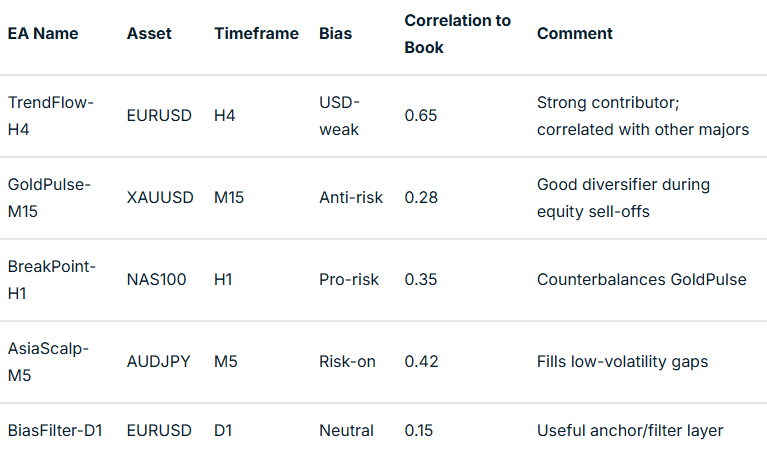
What Next? – Implementing Balance in Practice
Theory must ultimately translate into an executable EA book. A plan of action with landmarks to show progress and maintain motivation is crucial in this approach.
Defining classification tags, setting risk weights, and building monitoring dashboards are all worth consideration.
Advanced EA traders could also consider a supervisory ‘Sentinel’ EA, or ‘mothership’ approach, to enable or disable EAs dynamically based on underlying market metrics and external information integrated into EA coding decision-making.
Final Thoughts
A balanced EA portfolio is not generated by accident; it is well-thought-out, evidence-based and a continuously developing architecture. It is designed to offer improved risk management across your EA portfolio and improved trading outcomes.
Your process begins with mapping your existing strategies by number, asset, and timeframe, then expands into analysing correlations, directional bias, and volatility regimes.
When you reach the stage where one EA’s drawdown is another’s opportunity, you are no longer simply trading models but managing a system of EA systems. To finish, ask yourself the question, “Could this approach contribute to improved outcomes over time?”. If your answer is “yes,” then your mission is clear.
If you are interested in learning more about adding EAs to your trading toolbox, join the new GO EA Programme (coming soon) by contacting [email protected].


When you boil it all down trading is a game of numbers, the more numbers you make over time the more money you make however many traders don’t focus on the numbers game over time and instead focus their attention only on if they are winning or losing right now and it affects their ability to control their emotions. Here is a suggestion that could help you better focus on the numbers game rather than just focus on the Win or Loss right now. I like to call this process “Thinking in 10’s” but before I share the theory with you let me remind you that trading is not necessarily about how many times you win or lose.
Trading is about how much you win when you win and little you lose when you lose. Trying to find a system that wins 70%, 80% or even 90% of the time is extraordinarily difficult and any system that does have such a high strike rate for a period of time will eventually see a change in the percentage success. Just because it worked 70% of the time the past couple of months doesn’t mean it will continue to run at 70%.
Think about this for a moment. A trading system that has a risk / reward target of 1:2 meaning only needs to be correct 38% of the time to break even. Better than 38% and a 1:2 risk / reward strategy is potentially very profitable.
The probability when you trade is 50/50, the market can only go up or down, so gaining an edge to be at least 50% correct with a risk / reward target surely cannot be that difficult. It’s not the edge or % success that is the question, it’s the behavior of the trader in being able to focus over the long term on 1: 2 and not trade to trade. So consider thinking in 10’s.
Instead of evaluating your result day-to-day or week-to-week consider evaluating your performance after the next 10 trades. Lower your expectation on each trade, just follow your system, narrow your focus and ensure your risk is less than the reward and trade the plan for the next 10 trades. Then evaluate your overall result allowing the trades to show an overall success risk / reward ratio after 10 trades.
Many successful traders will be able to tell you what their risk / reward ratio is. In other words for every $1 they risk what is their average return? I think all traders should know these numbers and a good start would be to work out yours after the next ten trades.
So thinking in 10’s is all about following your strategy for 10 trades and not thinking win or loss per trade. Remember it's a numbers game over time, you will win some and you will lose some and it’s about how much you win when you win and how little you lose when you lose. Risk management is the key.
For more trading tips join me every Wednesday evening live online at 7pm AEST. You can simply click on this link and join the coaching session. http://gomarkets.webinato.com/room1 Andrew Barnett | Director / Senior Currency Analyst Andrew Barnett is a regular Sky News Money Channel Guest and one Australia’s most awarded and respected financial experts, and is regularly contacted by the Australian Media for the latest on what is happening with the Australian Dollar. Connect with Andrew: Email


Broadly speaking, inflation is a general increase in prices which result in a fall in the purchasing value of money. In this article, we are going to look at measures of inflation and other indicators that can help traders to detect early signs of inflation. Traders try to follow the inflationary pressures to anticipate the next interest rate move by central banks.
If the central bank sees that inflationary pressures are building up and that economic growth is accelerating, they can decide to raise the interest rate to combat inflation and slow down the economy. Producer Price Index (PPI) and Consumer Price Index (CPI) are widely used measures of inflation. PPI tracks wholesale price inflation while CPI follows retail price inflation.
As the name entails, PPI and CPI follow the changes in prices from the Producer’s and Consumer’s point of view respectively. PPI can be viewed as the leading indicator because higher producer prices will eventually be passed on to consumers.Therefore, PPI and CPI figures allow traders to forecast the central bank’s next move about the interest rate. Early Warning Signs of inflation There are other factors that can help traders to see that inflation is building up ahead of the release of PPI and CPI figures.
In doing so, forex traders are better able to trade inflation data more confidently. Consumer Confidence and Retail Sales These two economic data provide investors with an indication of the health of the consumers. Consumer Confidence offers an essential insight into the demand for goods and services regardless of consumers’ financial situation.
Consumers are likely to spend if they feel confident about the overall economy. Similarly, Retail Sales help to measure the trends in consumer spending which could cause investors to rethink the direction of interest rates. Labour Market and Wages - (Unemployment rate, Jobless Claims and Average Earnings) Employment rate helps to detect whether there is a shortage or oversupply of labour.
The simple demand and supply diagram of the labour market will provide you with the direction of wages when there are changes in the labour market. Wage inflation therefore translates into more spending and adds to inflationary pressures. Housing Market - (House Prices and Mortgage approvals) The correlation between the housing market and inflation can be a complex one.
However, for this article, we will look at house prices and interest rates. When interest rates are low, buying houses become more affordable. Depending on demand and supply, any change in house prices or mortgage approvals will provide insights on the inflationary outlook.
Inflation is critical for the Forex markets as it can exert a considerable influence on the exchange rate of a currency. Because central banks tend to adjust interest rate to fight inflation or deflation, forex traders monitor inflationary pressures very closely. It helps them to forecast whether the next move of the central bank will put downward or upward pressure on the currency.


We are four months into 2016 and the global economic prospects are still uncertain. The International Monetary Fund (IMF) chief has just issued another warning in recent days, stating that the outlook for global growth is weak and has encouraged policy makers across the world to work together to “bolster confidence, support growth, and guard more effectively against the risk of a derailed recovery”. According to the IMF, lower consumer-led expenditure and governments that are less likely to use fiscal facets to support the economy, coupled with high levels of public debt (which are now the highest since World War 2) are creating a prolonged low-growth environment that can have very serious socio-economic implications.
Most of the developed nations have already embarked on a negative interest rates policy to address the low economic growth. However, as evidenced by this warning, their efforts have not yet been successful and markets and economies are still facing many uncertainties. Euro Area interest rates at various maturities Potential Trading Opportunities Although sluggish growth and negative interest rates are not pleasing for the majority of fund managers and pensioners, certain drivers and trends can potentially create opportunities to the benefit of traders.
Below is an overview of some of these drivers and their follow-on impact on the Japanese Yen, ASX200, gold and the Aussie dollar. Please note that these are our analysis of the market environment. They are not trade recommendations and you should have your own risk management strategy in place when trading the markets. 1) Opportunities and challenges in the banking sector All traders, whether equity or FX, should always keep an eye on the banking sector because stress and pressure in this space can affect every tradeable security across the globe (remember GFC?).
The low growth environment has put banks under downward pressure from various sources. First, it has limited the amount of investment activities which has inherently meant lower revenues for banks which are the traditional providers of investment capital. Second, it has made many banks deal with negative interest rates.
Banks are not yet willing to pass the negative rates to their customers because they want to keep their market share and to discourage people from cashing in their deposits. Therefore, negative rates have caused bank profits to shrink as the difference between interests they receive and the interest they pay has narrowed. Third, the prolonged lower commodity prices resulting from slower demand from China and other emerging economies has pushed a number of mining and energy companies, which have had large debts, to the edge of bankruptcy.
This is obviously bearish for banks as they have been the capital (loans) providers to these companies. Although Australian banks don’t yet have to deal with prospects of negative rates, they have pretty much remained in synch with their overseas counterparts, thanks to the end of the mining boom and lower commodity prices and bankruptcies in the mining and energy sector. For example, ANZ Bank has just announced that they will lose an extra $100 million in mining related bad debts.
Furthermore, Aussie banks are quite vulnerable to the property market here in Australia. Over the years, Australian banks have loaned out billions of dollars to property investors and therefore would have a lot to lose should the property market bubble burst. Major four banks performance From a trading perspective, deterioration in the banking sector can cause a chain of systematic risks which in turn may switch on a number of “risk off” trades.
Using the historical relationship between banks and asset markets, I have calculated that if the current downward trend in global and domestic banks accelerates and markets start to price in an additional weakness in this sector, some trading opportunities may arise in AUDUSD, AUDJPY, ASX 200 and Gold (In AUD). The table below shows how much these assets may move should Australian banks drop by an extra 20% from here: As you can see, ASX 200 index and AUDJPY traders may actually find meaningful medium-term trends should the banking sector start to deteriorate again. AUDJPY has recently enjoyed great buying support from yield-hungry Japanese investors as Australian currency offers a relative attractive yield.
At the moment, the pair has found solid resistance around 86.00 and deterioration in the banking sector can be a catalyst for this resistance to uphold and push the currency pair back to the 78 -79 band. 2) Trading Interest Rates Movements The U.S interest rate set by the Federal Reserve plays a significant role in any short and medium term trading. In response to continued low growth prospects and in the aftermath of the January and February volatilities, the once hawkish Fed which was singling 4 rate rises for this year, has stepped back and is currently signalling a rather softer tone towards rate rises. Just to remind the readers that interest rates are a measure of economic activities.
When policy makers think the economic conditions are getting stronger, they would raise interest rates to control the inflation. When they see economic conditions worsening, they reduce interest rates to stimulate the economy. The graph below (also known as the Dot Plot in the investment community) shows how the Fed governors were thinking about the 2016 economy (in terms of interest rates) both in Dec 2015 and March 2016.
The numbers on the left axis are the projected interest rates and the size of each circle shows the number of governors forecasting a particular rate. As you can see, in Dec 2015, the majority of Fed officials were thinking the rates would go around 1.35% by the end of 2016. However, since then, things have changed and the majority of Fed governors are now thinking we are more likely to be around 0.85% by the end of 2016.
Should the above dots keeps falling to the stage where U.S signals a possible rate cut and more importantly, a move towards negative interest rates, it will have some drastic impact on many tradeable securities. If markets start to price in any chance of U.S rates going negative, the Aussie dollar will lose significant amounts to USD, JPY and gold. The details are in the table below: Though I’m not predicting that the U.S rates will go negative, we are now living in an unchartered territory where everything seems to be possible.
If you talked about the likelihood of negative rates two years ago, most analysts would have laughed you out the door. But here we are today with most of the developed nations interest rates in the negative territory. Therefore, I would closely monitor anything related to the US interest rates.
US-10 year yield since December 2015 3) Trading Opportunities in USD/JPY pair While analysts are scattered around the future direction of the US dollar itself due to Fed’s change of tone, the case of the USDJPY is relatively straightforward. It’s the world’s most traded safe haven currency and trends downwards each time there is another negative surprise or volatility in the markets. In theory, USDJPY should have gone up when the Bank of Japan (BOJ) introduced negative interest rates earlier this year.
However, due to lack of investment opportunities brought by the low growth world and the fact that this pair acts as a barometer for global risk environment, it dropped by some 9.7% since the start of the year and brought short-term traders an abundance of trading opportunities (please refer to our previous article about this point). At the moment, there is nothing that suggests the current economic conditions are going to disappear. It is possible that the existing downward trend USDJPY can in fact continue for as long as the Fed is not taking a serious stance on U.S interest rates.
The biggest risk to the above scenario is a possible BOJ market intervention. The stronger Yen (lower USDJPY) is negative for Japanese economy as it makes their products more expensive abroad. Japan’s economy is highly export driven and higher Yen does not help.
Therefore, at some stage BOJ may decide that enough is enough and start selling Yen in a large scale to push their currency lower. But if history is of any guidance, BOJ’s probable intervention may only create additional shorting opportunity as these interventions have a poor record of effectiveness in changing the currency pair’s downward trends. The opinions and information conveyed in the GO Markets newsletter are the views of the author and are not designed to constitute advice.
Trading Forex and CFD’s is high risk. Ramin Rouzabadi (CFA, CMT) | Trading Analyst Ramin is a broadly skilled investment analyst with over 13 years of domestic and international market experience in equities and derivatives. With his financial analysis (CFA) and market technician (CMT) background, Ramin is adept at identifying market opportunities and is experienced in developing statistically sound investment strategies.
Connect with Ramin: Twitter | LinkedIn


If you are willing to look at your Forex experience a bit like an apprentice completes an apprenticeship you are likely going to achieve a higher level of success. Why should opening a live account and making money in the financial markets be any different to any other career? You don’t get to build a house without the appropriate qualifications nor do you get to fly a plane without taking hours of flying lessons and passing some final tests.
A professional sports person spends hours building their body, mind and talent to compete at the highest level but being a Forex trader for some reason is often considered differently. Why? Because as human beings we want instant gratification and because online forex trading involves the opportunity to make money we as humans are greedy and are usually not prepared to take a logical and sensible approach to learning, practice, discipline and patience.
We want it all now so the gambling approach can take over. When you trade forex you are effectively competing and the online trading competitors who you are playing against (banks, institutions) are some of the most experienced, knowledgeable and at times ruthless currency trading competitors on the planet. They want to win and your best chance of winning in my experience is to learn to ride their coat tails and trade similar strategies and systems, which also includes extremely tight risk management.
For example most successful forex banking traders have honed their skills for years often working their way up from a retail banking position, through the research departments, through the company courses and finally over time into a forex trading position on the trading desk. They’ve done an apprenticeship. With such strong competition does this ultimately put you in an uncompetitive position?
No, provided you are willing to spend the time to learn about the fundamentals and technical charts that give you an edge and apply professional risk management you can succeed in the currency markets. There is no question you will fail along the way just as every apprentice failed at times through their apprenticeship but if you do things steadily and slowly you will likely fail gracefully as you learn and stay in the currency trading game long term. Success in the currency markets requires one very important ingredient.
Time! You are going to need time and you need to be able to give yourself the time to fail, time to win, time to learn and time to grow as a currency trader. Think of trading forex like an apprenticeship and you are likely going to achieve a higher level of success.
Join me live online every Wednesday evening at 7pm AEST for a Free Professional Forex training lesson. I will do my best to share with you the important fundamental and technical information to make your currency apprenticeship as enjoyable as possible. To log into the session simply use the following link.
Please make sure you are logged in at 6.45pm AEST as the room is often full. http://gomarkets.webinato.com/room1 Andrew Barnett | Director / Senior Currency Analyst Andrew Barnett is a regular Sky News Money Channel Guest and one Australia’s most awarded and respected financial experts, and is regularly contacted by the Australian Media for the latest on what is happening with the Australian Dollar. Connect with Andrew: Email


Candlestick charts are one of the most popular and commonly used tools by traders in analysing the markets. In this article, we will briefly look at its history then move on to some basics on how to interpret these charts. We will also look at some of the major candlestick chart patterns to give you an understanding of how you can use them for your trading analysis.
A brief history of candlestick charts Candlestick charts originated in Japan in the 18 th century and is one of the earliest known forms of technical analysis. Today, it is the most popular chart used by FX traders as it provides a quick and easy picture of price action in a particular trading session. Analysing and understanding a candlestick A candle is made up of a rectangular ‘body’ and single lines at both ends called ‘wicks’.
Candlesticks provide a more visual representation of price action than you get from simple Bar or Line charts. For the purpose of this article, the bear (down) candle will be red, and a bull (up) candle will be blue. One candle will represent one whole trading day.
However, it is important to note that with the MT4 platform you can also set up the candlestick chart to reflect 1 min, 5 min, 15 min, 30 min, 1 hour, 4 hour, daily, weekly and monthly time frames. Candlestick body represents strength of price action As per the diagram below, the formation of a candlestick represents the open, high, low and close price for the day. The length of the body shows the strength of the price action.
The longer the body of a candlestick, the stronger or more aggressive the price action is. In the example below shows two similar size candles, however, the second one is a stronger bullish candle as the body is longer. Wicks represent buyer and seller activities The thin lines above and below the body are called ‘wicks’ and represent the high and low range of the price for the day.
The wick on top of the body represents sellers and selling activity. The bottom wick indicates the presence of buyers and buying activity. The length of the wick gives a good indication of the strength of the type of activity i.e. a longer wick is more definitive than a shorter one.
A long upper wick and short lower wick indicates that there were buyers earlier in the day pushing prices higher. However, strong sellers later on in the session forced the prices down from their highs, creating a long upper wick. A long lower wick and short higher wick indicates that sellers dominated earlier in the day, however, stronger buyers entered later in the session pushing the prices higher from their lows and creating a long lower wick.
Common Candlestick chart formations Here are some of the most common candlestick chart formations that FX traders use for their trading analysis. Spinning Tops A Spinning Top is a Candlestick with a short body and a long upper and lower wick. It indicates uncertainty in the market and puts a question over which way prices may be heading.
The long wicks indicate strong buying and selling activities at some stage during the trading session, but with no clear winner at the end. If a Spinning Top occurs towards the end of a trend it may indicate that the trend is coming to an end. If it occurs while the market is moving sideways, it may indicate a start of a trend.
A Spinning Top is usually a Neutral signal. Doji A Doji candlestick is formed when the opening price is the same or very close to the closing price. It signals a balance between buyers and sellers.
A Doji with a long upper wick indicates the initial presence of buyers. The price has initially moved higher and eventually attracted sellers. In this case, the sellers are seen as the stronger group, as they closed out the day.
A Doji with long lower wick indicates the initial presence of sellers. The lower prices attracted buyers, who ended up being the stronger group as they closed out the trading session. Looking at a Doji on its own may not give a clear buy or sell signal.
But looking at it and taking into consideration preceding candles, it can provide some valuable information. For example, if a Doji occurs at the end of a trend or even one trading session, it may be a sign that a potential change in direction may happen. It might also occur at the end of a congestion phase.
It might follow an up candle or a down candle. The strength of the previous candle, as measured by the length of the real body, will give traders an idea on how to interpret the Doji signal. In the diagram below, a Doji appears after a relatively bullish session.
This can either indicate a start of a new phase of the uptrend (if a trend exists), or a potential change into a new (bearish) direction. Gravestone Doji It is a reversal pattern that could mean a bullish rally is about to end. This is formed when the open, low and close are equal and the high creates a long upper wick.
The resulting candlestick looks like an inverted “T”. A Gravestone Doji indicates that buyers dominated trading and drove prices higher during the early part of the session. However, by the end of the trading day, sellers started to appear and pushed prices back to the opening level and the session low.
A Gravestone Doji is usually a bearish signal. Dragonfly Doji This Doji formation is another signal of indecision between buyers and sellers. A Dragonfly Doji is formed when the open, high and close are equal and the low creates a long lower shadow.
The resulting candlestick looks like a “T”. A Dragonfly Doji indicates that sellers dominated early trading and drove prices lower during the session. But by the end of the session, buyers appeared and drove prices back to the opening level and the session high.
A Dragonfly Doji is usually a bullish signal. Harami A Harami is a reversal pattern and consists of two candlesticks. A Harami formation can be bullish or bearish depending on the direction of the price action.
The most important thing to consider when looking for a Harami is the gap up and gap down in price. A bearish Harami is formed when a large bullish candle (Day 1) is followed by a small bearish or bullish candle (Day 2) which showed a gap down in price. A bullish Harami occurs when a large bearish candle (Day1) is followed by a small bearish or bullish candle that showed a gap up in price.
The important thing to consider is the size of the body of both candles as it is indicative of the strength of the signal. The first candle should have a rather large body. The smaller the body in the second candle the stronger the signal.
Example of a Bearish Harami: Hammer A Hammer is a bullish reversal pattern usually formed at the end of a declining price trend. It is identified by its small body at the higher side of the range. The bottom wick should be at least twice the size of the real body and the upper wick should only be small, if it exists at all.
In chart analysis, it is the length of the wick (of a Hammer formation) relative to the body that creates the signal. The wick could be viewed as a sign of rejection of lower prices and therefore a possible reversal of the trend. Hanging Man A Hanging Man is a bearish reversal pattern.
Its formation is similar to the hammer formation, except that it occurs at the end of a bullish trend. Once again the body is at the top of the range with the lower wick at least twice as long as the body. The upper wick should be short if it can be found at all.
It is best to seek confirmation of a bearish reversal with a follow-up signal the next day. These are just some of the basic candlestick patterns. There are numerous books and online resources available about Candlestick charting.
If you you’re new to FX trading, it would be highly recommended to read up on Candlestick charts to find out how you can use it for your trading. For information on other trading tools, see our Autochartist, Genesis for MetaTrader, VPS for MetaTrader and a-Quant information pages. Rom Revita | Sales Manager Rom is the Sales Manager at Go Markets Pty Ltd and manages the day-to-day running of the Sales, Support and Marketing teams.
He has been with the company since 2013 and is also one of our two appointed Responsible Managers, helping to ensure that the company follows all AFSL regulatory requirements. Rom has extensive financial markets experience and originally comes from an equities & derivatives trading background. He has served on the Trading & Sales Desk with several large broking houses, and now specialises in Margin FX and CFDs.
Connect with Rom: [email protected]


军形篇 - The Chapter of Tactical Dispositions Original Text: 善战者,先为不可胜,以待敌之可胜。 Translation: Good commanders first evaluate the possibility of being defeated and then wait for an opportunity to defeat the enemy. Don’t you think this sounds very similar to using a trading stop-loss? The concept of setting up a stop-loss is to estimate and prepare for the worst case scenario.
As a commander, Master Zhu would suggest you treat the money in your account as your soldiers and take care of their lives. Let's say you're on the battlefield and you strategize that a plan of attack might sacrifice 50% of your army, that's 50% of your soldiers' lives (i.e., 50% of your account balance), surely no respected commander would approve that kind of attack. However, in forex trading, some people will quickly lose 50% of their money in a short period.
In Sun Zhu's eyes, this would make for a very unqualified commander. Therefore, placing a stop-loss that could cause you to lose 50% in a single trade is a poor decision. Most experienced traders might suggest a 2%~5% stop is a wiser move.
Even a 10% stop may be considered quite extreme. Would you risk the lives of 10% of your infantry? Some might argue that it depends on the circumstances, either way, the same level of consideration must be given in trading to have any chance of success.
Also, most traders lose 50% of their account or more because they fail to place any stop-loss measures at all. Under the context of the Art Of War, this means you never bothered to estimate the worst scenario before you attacked. In Master Sun’s eyes, that is extremely unacceptable.
Original Text: 不可胜在己,可胜在敌。 Translation: The ability to secure ourselves against defeat lies in our own hands. The opportunity to defeat the enemy is provided by themselves. A very remarkable concept.
Many investors believe they can actively beat the market, which is wrong. The market is far stronger and smarter beast than the average person. Instead of trying to "beat" the market, more time and effort should go into improving yourself.
For example, try focussing on how to better to defend, such as setting up suitable stop-losses as the previous saying suggests. Once you've developed the ability to protect your soldiers, then all you need is to do is wait for an opportune time to attack (you can observe it from chart patterns), then and only then, will you be trading like an intelligent commander, prepared to lose a battle and win the war. Original Text: 故善战者,能为不可胜,不能使敌之必可胜。 Translation: Thus, a good commander can secure himself against defeat but cannot make sure of defeating the enemy.
Master Sun corrects us here on another common misunderstanding. Nowadays many fund managers will brag about their “target profit” to attract your attention. As an individual investor, you might be vulnerable to being misled and start to think “maybe it's good to set a target profit for my investing too?.” Well, Sun Tzu would argue that this is wrong.
If you set a target return for yourself and you are unable to achieve it, you will most likely become hurried and vulnerable. Imagine your basketball team is losing and it's the last few minutes of the game. How many times have we seen teams abandon their defensive tactics, throwing caution to the wind and put everything they have into the final attack?.
Perhaps having Michael Jordan on the court may help, but ultimately, this scenario doesn't end well for those losing teams. With little to no defense in place, the opposing team will typically score more points and much more easily than before making matters worse. The same logic applies to the financial markets.
There is a general tendency to increase your position and attack more at the worst possible time, and the market will more often punish those who fail to defend their position adequately. Original Text: 故曰:胜可知,而不可为。 Translation: Hence the saying: You may know how to win, but sometimes you are not able to do it. Original Text: 见胜不过众人之所知,非善之善者也; Translation: To see victory only when it is within the ken of the common herd is not the acme of excellence.
Original Text: 战胜而天下曰善,非善之善者也。 Translation: Neither is it the acme of excellence if you win and the whole world says, “Well done!” to you. In this paragraph, Sun illustrates another common misunderstanding by the general public. You probably heard of the 20-80 rule, which states that roughly 20% of the population controls 80% of the global wealth.
You may have also heard that 20% of the population will win at trading while the other 80% will lose. When it comes to trading, this theory suggests the most popular idea about price direction will cause you to lose money in the long run. Thus, if your opinion falls within the common herd, then perhaps you need further training as a trader.
Many beginner traders will follow those famous pundits on the major television stations. You know the ones I'm talking about, those who claim they can predict the market direction with 80% accuracy and never fail. If we consider the 20-80 rule above, then this claim starts to sound quite absurd or should at least raise some internal alarm bells.
Most of these analysts have a claim to fame because they successfully predicted one or two big financial events, say the start of the 2008 crisis. Does this mean they can accurately predict every other upcoming event with such accuracy? Of course not, nobody can.
Hence, Sun Zhu said those who won the applause of the whole world might not be as good as you think. Original Text: 故举秋毫不为多力,见日月不为明目,闻雷霆不为聪耳。 Translation: To lift a hair is no sign of immense strength; to see the sun and moon is no sign of sharp sight; to hear the noise of thunder is no sign of a quick ear. Original Text: 古之所谓善战者,胜于易胜者也。 Translation: Thus the ancients said an excellent winner is one who not only wins but excels in winning with ease.
Original Text: 故善战者之胜也,无智名,无勇功, Translation: Hence his victories bring him neither reputation of wisdom nor credit for courage. Original Text: 故其战胜不忒。不忒者,其所措胜,胜已败者也。 Translation: He wins his battles by making no mistakes. Making no mistakes is what establishes the certainty of victory, for it means conquering an enemy that is already defeated.
Here Sun describes for us what kind of person can be known as an “excellence winner.” This person has trading success based on defense. They make minimal mistakes (i.e., choosing the right time, trend and setting up sensible stop-losses) they also understand that some losses are inevitable while protecting their account for future battles. This kind of success is often very low-key.
It's unlikely to receive any applause or stardom because he or she is not looking to parade their wins in public as it's all part of a more important strategy. Original Text: 故善战者,立于不败之地,而不失敌之败也。 Translation: Hence a skillful commander puts himself into a position which makes it impossible for being defeated and does not miss the moment of defeating the enemy. Original Text: 是故胜兵先胜而后求战,败兵先战而后求胜。 Translation: Thus a victorious strategist only seeks battle after the defense is guaranteed, whereas a losing strategist first encounters a fight and then looks for victory.
These two sentences summarized what we had covered today. First, make sure it is impossible to be defeated (by managing your positions and stop-losses well). In essence, this means even though losses are possible, blowing up an account on a single trade is not.
Seek the most opportune time for a battle (Open a position). Don't just go with the crowd. Do your analysis and study wisely.
Once opened, closely monitor the five elements of the markets ( we covered this in part 1 of this series), then you are heading towards victory. By Lanson Chen – Analyst Lanson Chen @LansonChen This article is written by a GO Markets Analyst and is based on their independent analysis. They remain fully responsible for the views expressed as well as any remaining error or omissions.
Trading Forex and Derivatives carries a high level of risk.

